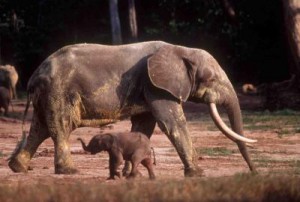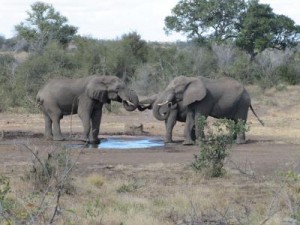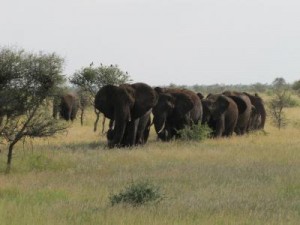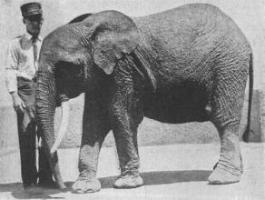
December 22, 2010
The following announcement, of course, does not take into account the fact that there may be a third species of African elephant, the pygmy, but more of that at the end.
Contrary to the belief of many scientists (as well as many members of the public), new research confirms that Africa has two—not one—species of elephant. Scientists from Harvard Medical School, the University of Illinois, and the University of York in the United Kingdom used genetic analysis to prove that the African savanna elephant and the smaller African forest elephant have been largely separated for several million years.
The researchers, whose findings appear online in PLoS Biology, compared the DNA of modern elephants from Africa and Asia to DNA that they extracted from two extinct species: the woolly mammoth and the mastodon. Not only is this the first time that anyone has generated sequences for the mastodon nuclear genome, but it is also the first time that the Asian elephant, African forest elephant, African savanna elephant, the extinct woolly mammoth, and the extinct American mastodon have been looked at together.
“Experimentally, we had a major challenge to extract DNA sequences from two fossils—mammoths and mastodons—and line them up with DNA from modern elephants over hundreds of sections of the genome,” says research scientist Nadin Rohland of the Department of Genetics at Harvard Medical School.

Forest elephants (shown) in Africa have now been confirmed as a new species of elephant and have been distinguished from the larger savanna elephant in Africa.
According to David Reich, associate professor in the same department, “The surprising finding is that forest and savanna elephants from Africa—which some have argued are the same species—are as distinct from each other as Asian elephants and mammoths.”
Researchers only had DNA from a single elephant in each species, but had collected enough data from each genome to traverse millions of years of evolution to the time when elephants first diverged from each other.
“The divergence of the two species took place around the time of the divergence of the Asian elephant and woolly mammoths,” says Professor Michi Hofreiter, who specializes in the study of ancient DNA in the Department of Biology at York. “The split between African savanna and forest elephants is almost as old as the split between humans and chimpanzees. This result amazed us all.”
The possibility that the two might be separate species was first raised in 2001, but this is the most compelling scientific evidence so far that they are indeed distinct.
Previously, many naturalists believed that African savanna elephants and African forest elephants were two populations of the same species, despite the significant size differences. The savanna elephant has an average shoulder height of 3.5 meters whereas the forest elephant has an average shoulder height of 2.5 meters. The savanna elephant weighs between six and seven tons, roughly double the weight of the forest elephant.


Africa’s savanna elephant (shown) is as different from Africa’s forest elephant as Asian elephants are to mammoths, says a new study in PLoS Biology.
DNA analysis revealed a wide range of genetic diversity within each species. The savanna elephant and woolly mammoth have very low genetic diversity, Asian elephants have medium diversity, and forest elephants have very high diversity. Researchers believe that this is due to varying levels of reproductive competition among males.
“We now have to treat the forest and savanna elephants as two different units for conservation purposes,” says Alfred Roca, assistant professor in the Department of Animal Sciences at the University of Illinois. “Since 1950, all African elephants have been conserved as one species. Now that we know the forest and savanna elephants are two very distinctive animals, the forest elephant should become a bigger priority for conservation purposes.”
###
This research was funded by the Max Planck Society and by a Burroughs Wellcome Career Development Award in Biomedical Science.
###
Then there is the matter of Pygmy Elephants, which are today reported to be living in both Africa and Asia.

The controversial Pygmy Elephant (Loxodonta pumilio) of Africa has been confirmed by film/video footage and photographs of entire herds of the species as requested by its opponents. These individuals now say that it is an unknown behavior or morph of the forest elephant, thus, as expressed firmly in personal communication to me by Michel Raynal, this “demonstrates that no evidence will be accepted by these ultra-skeptics.”
The African Pygmy Elephant, described as Loxodonta pumilio, is currently considered to be a tiny morph of the African Forest Elephants (L. cyclotis); see Debruyne et al. (2003). But even the DNA studies are less than clear, and the groupings and photographs of the small elephants appear to confirm that the species is valid.
The Borneo Elephant (Elephas maximus borneensis) is also called a “Pygmy Elephant.” This elephant, inhabiting tropical rainforest in north Borneo (east Sabah and extreme north Kalimantan), was long thought to be identical to the Asian Elephant and descended from a captive population. In 2003, DNA comparison revealed them to be a new subspecies. In Augut 2007, it was reported that there are probably not more than 1,000 pygmy elephants left in Sabah, after a two year study by WWF.

Further discussions are now mentioning the cryptid status of the Pygmy Elephants of India. Kani tribals dwelling in the rain forests of the Western Ghats, Kerala, India, claim that there are two distinct varieties of elephants in the Peppara forest range (part of Western Ghat), one the common Indian elephants and the other a dwarf variety which they call “Kallana.” The existence of a pygmy variety of elephant in India has not been scientifically ascertained.
Eisentraut, Martin, und Wolfgang Böhme 1989 “Gibt es zwei Elefantenarten in Afrika?” Zeitschrift des Kölner Zoo, 32 [n° 2] : 61-68.
Debruyne, R., Holt, A. van, Barriel, V. & Tassy, P. 2003. “Status of the so-called African pygmy elephant (Loxodonta pumilio (NOACK 1906)): phylogeny of cytochrome b and mitochondrial control region sequences.” Comptes Rendus de Biologie 326(7):687-697.
Böhme, Wolfgang, und Martin Eisentraut 1990 “Zur weiteren Dokumentation des Zwergelefanten (Loxodonta pumilio NOACK, 1906).” Zeitschrift des Kölner Zoo, 33 [n° 4] : 153-158.
About Loren Coleman
Loren Coleman is one of the world’s leading cryptozoologists, some say “the” leading living cryptozoologist. Certainly, he is acknowledged as the current living American researcher and writer who has most popularized cryptozoology in the late 20th and early 21st centuries.
Starting his fieldwork and investigations in 1960, after traveling and trekking extensively in pursuit of cryptozoological mysteries, Coleman began writing to share his experiences in 1969. An honorary member of Ivan T. Sanderson’s Society for the Investigation of the Unexplained in the 1970s, Coleman has been bestowed with similar honorary memberships of the North Idaho College Cryptozoology Club in 1983, and in subsequent years, that of the British Columbia Scientific Cryptozoology Club, CryptoSafari International, and other international organizations. He was also a Life Member and Benefactor of the International Society of Cryptozoology (now-defunct).
Loren Coleman’s daily blog, as a member of the Cryptomundo Team, served as an ongoing avenue of communication for the ever-growing body of cryptozoo news from 2005 through 2013. He returned as an infrequent contributor beginning Halloween week of 2015.
Coleman is the founder in 2003, and current director of the International Cryptozoology Museum in Portland, Maine.
Filed under Breaking News, CryptoZoo News, Megafauna, New Species